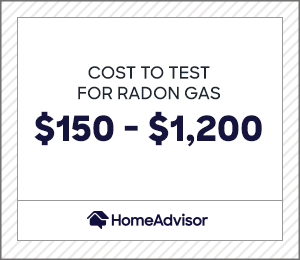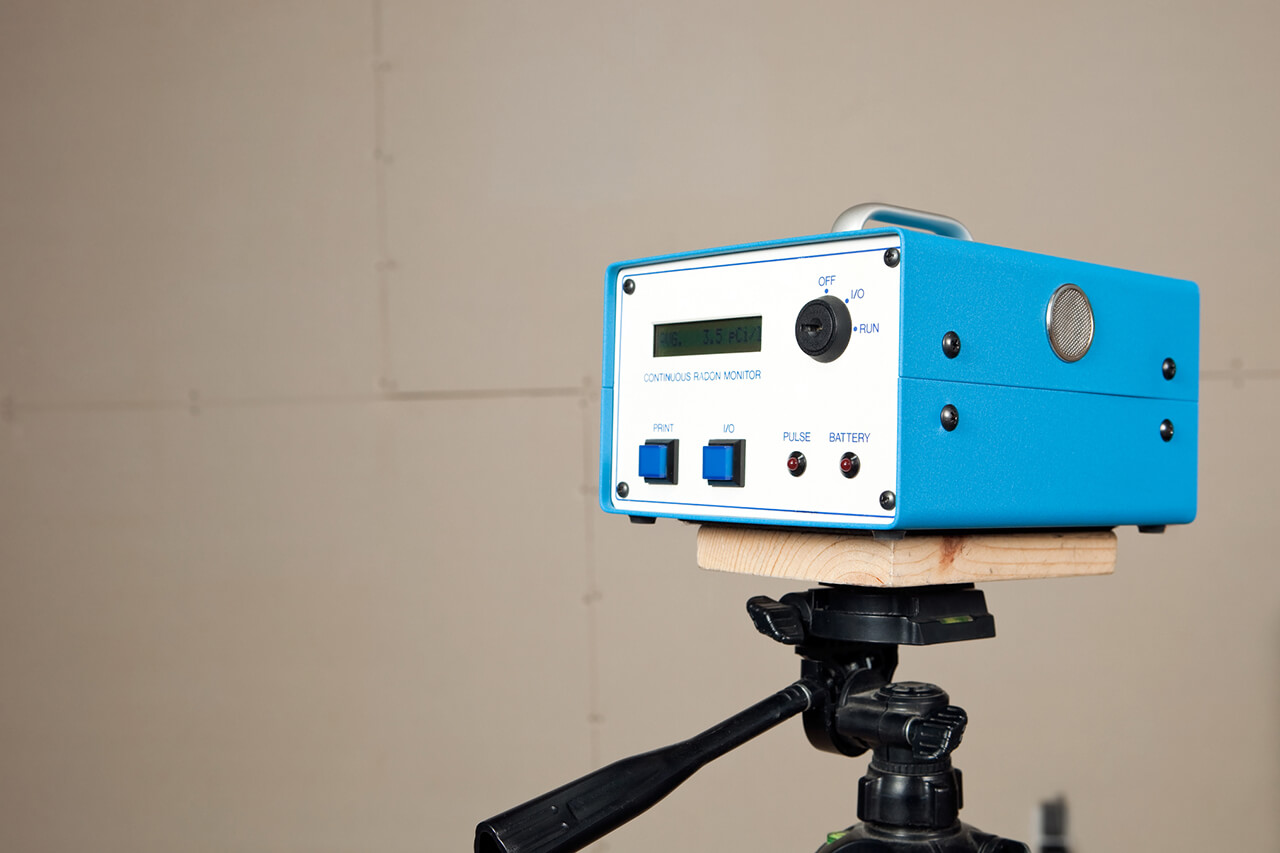How Much Does a Radon Inspection Cost?
Typical Range:
$145 - $715
Typical Range:
$145 - $715
Cost data is based on actual project costs as reported by 1,164 HomeAdvisor members. Embed this data
.
.
.
.
.
.
.
.
.
.
.
.
.
.
.
.
.
.
.
.
.
.
.
.
.
.
.
.
.
.
•
•
•
•
Published January 10, 2022
Written by HomeAdvisor.A radon inspection ranges between $145 and $715, averaging at $419. Home test kits range between $10 and $30. However, hiring a pro is the most accurate method of testing. Costs to mitigate average $1,000 and are separate from testing.
Radon is a radioactive, odorless, colorless gas formed by the decay of radium in soil, water and natural gas. It is the number two cause of lung cancer. The Environmental Protection Agency recommends that all homes be tested to ensure the gas is below recommended safety levels.
Let's calculate cost data for you. Where are you located?
Where are you located?
| National Average | $419 |
| Typical Range | $145 - $715 |
| Low End - High End | $100 - $1,200 |
Cost data is based on actual project costs as reported by 1,164 HomeAdvisor members.
Typical inspections average between $150 and $300. Home size and region affect the cost. Some inspectors test for radon during a general home inspection. A professional can detect whether you have a problem and the severity of it.
Some pros use multiple kits for larger homes, increasing costs. The number of levels and the layout of the house, such as whether there is a firewall between a garage and a living area, affect an inspector's decision to use multiple kits. This may increase costs by $30 to $300 depending on your house and the inspector.
Some pros use digital devices for measurement and do not charge extra for larger houses.
Living in an area with an active housing market may drive up cost. Demand is high for Inspections since they're typically done for real estate transactions. Contact multiple pros in your area to get the best value and highest quality service.
Some testing companies may add a travel expense if your home is outside of their service radius. Contact a local radon testing pro near you for a quote.
Most inspectors bundle a test into the cost of a standard home inspection during a real estate transaction. This adds between $90 and $250. Because the inspector is already on site, it always costs less as part of an overall inspection than doing a standalone measurement.
The cost of kits ranges from $10 to $200 depending on the model. Kits can be passive or active. Passive devices can be long- or short-term. Some do not require power to function. You can send these to a lab for analysis. Active devices are long-term and require power to continuously sense and report levels in the home.
If you plan to use a DIY device, check to make sure it is EPA approved. Take precautions against interference. Follow instructions during the test period to ensure reliable results.
Remember that hiring a certified pro is worth the cost of around $200. Pros know the proper conditions, guidelines and equipment for the job.
Short-term kits use charcoal for a passive reading. These cost between $10 and $30 at hardware or general stores like Home Depot or Amazon. Leave these in the lowest part of your home for two days, mail in the results, and await a response. Levels change depending on the weather, season, and to what degree the windows and doors have stay open or closed. Use more than one short-term kit to get a reliable reading.
| Pros | Cons |
|---|---|
| Fast results | Subject to inaccuracy |
| Inexpensive | More money and time may be necessary for multiple tests |
Long-term kits range between $10 and $200 depending on whether they are passive or active. These measure levels over a longer period, bypassing fluctuating results.
Passive long-term kits: $10-$30 in hardware stores or online. The alpha-track model collects particles for up to 91 days to a year with a plastic strip.
Active long-term sensors or continuous monitors: around $200. These display a regular report of current levels in your house.
If a short-term test detects a problem, homeowners often utilize long-term tests to confirm the result and measure going forward.
| Pros | Cons |
|---|---|
| Accurate results | Delay in results |
| Passive or active options | Require maintenance |
Hiring a pro to measure water levels prices around $200. This involves collecting a water sample and sending it to a lab to await results.
The EPA enforces testing for public water suppliers, but private ground wells require regular attention. The Center for Disease Control recommends searching state-certified laboratories to check private ground wells once a year.
Kits cost between $15 and $40 at hardware stores and online. If it's found in the well, then a pro will install a water mitigation system. These average around $4,500.
If your home shows high levels, call a pro. Learn your options, consider the cost of radon remediation methods, and choose the best abatement route for your house and safety.
Mitigation systems may introduce a series of fans, pipes and filters in specific areas of your house. Systems and installation will resemble installing a central humidifier or air purifying system.
Sealing gaps around utility pipes, basement floor cracks, and foundation cracks lowers radon problems, or the levels of gas entering through the soil. This will also keep other mitigation costs down.
Ventilation systems use fans to draw air into the house. This forces the existing air to exit through windows and vents. Ventilation curbs mitigation costs by introducing outside air, but it can be tough to maintain during colder months. A heat recovery ventilator heats or cools incoming air using the exhausted air. This can help with any heat loss issues.
Multiple forms of suction can draw the gas outdoors, diluting it.
Submembrane suction works similarly to sub-slab suction. This is for houses with crawlspaces. A heavy plastic sheet covers a dirt floor. Then a pro inserts a pipe into the ground beneath. A fan connected to the pipe above or outside the home creates a vacuum to expel the gas.
Block-wall suction attaches to basements with hollow block foundation walls.
Suction can also attach to water drainage systems such as drain tiles or sump pumps. Learn more about the cost of waterproofing your basement or foundation.
Sub-slab suction or depressurization refers to homes with a basement or slab-on-grade foundation. This method draws the gas from below your foundation using pipes inserted through or below the floor slab into the soil beneath. A fan in the attic or above the house creates a vacuum to release the gas outside. It is the most common and expensive, but also the most effective system.
Though a DIY kit is inexpensive, there are many opportunities for interference with the results and incorrect usage. A professional inspector knows the best procedure, guidelines and equipment to get a reliable reading.
When hiring a pro, have them inspect everywhere. Do not open windows and doors to air out the house during testing. This can skew the accuracy of the results.
The National Cancer Institute labels radon as the second leading cause of lung cancer as it breaks down cells inside the lungs when inhaled. Know your home's health risks. Because it is odorless and invisible, test your home for radon about every two years. It is especially important to measure again if you are occupying different areas of your home such as the basement or if you have remodeled.
The EPA recommends measuring for radon every two years and after any home renovations. Around one in every 15 homes has elevated levels.
Make sure a quality radon test is included in your home inspection before purchasing. Some local and state governments even require the disclosure of inspections to buyers in real estate transactions. If you are selling your house, including a recent radon inspection can be a positive selling point.
Do not rely on your region or your neighbors' homes to estimate levels in your house. These are not accurate predictors.
Many professionals, often home inspectors or mitigation companies, offer tests. Some states have requirements to certify service providers. Only hire a pro certified by the EPA for indoor air quality issues.
Many companies offer several types of services that can include testing and mitigation together. Other inspectors may refer you to a mitigation service.

